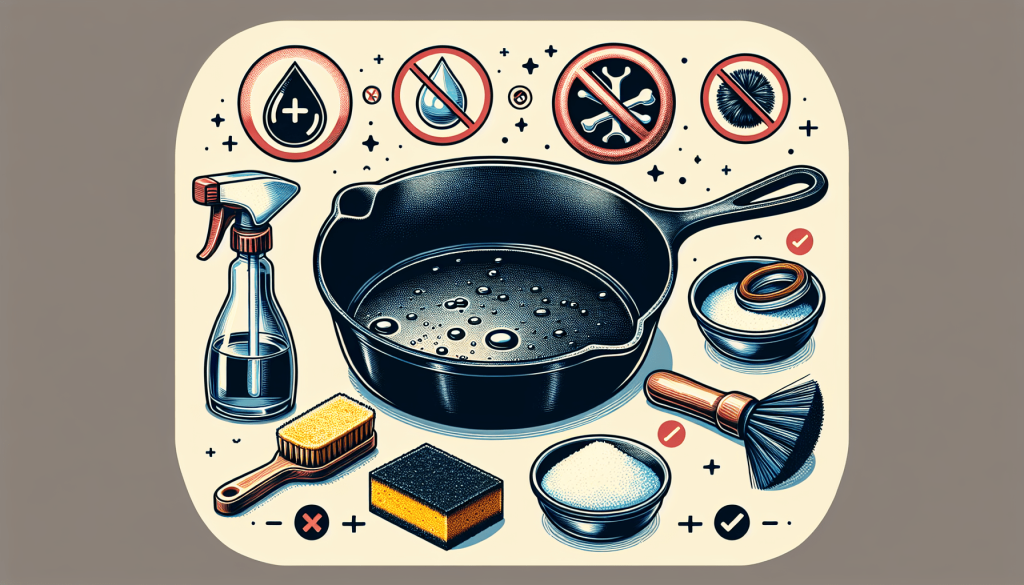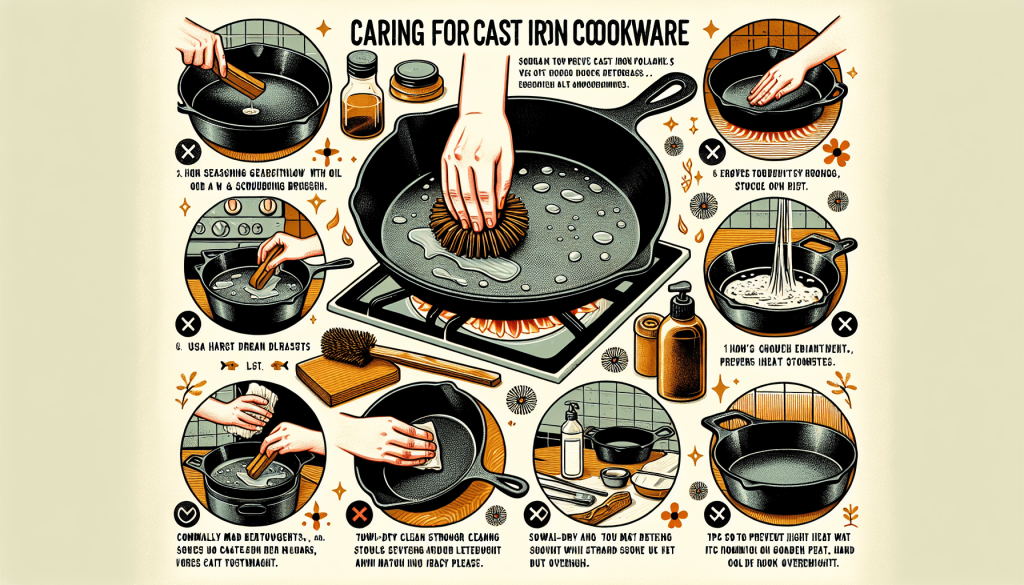In this article, you will discover the secrets to properly seasoning and caring for your cast iron cookware. Whether you’re a seasoned chef or just starting out in the kitchen, these tips and tricks will help you maintain the longevity and performance of your beloved cast iron pans. From the initial seasoning process to daily maintenance, you’ll learn everything you need to know to keep your cookware in tip-top shape. So grab your apron and get ready to learn the ins and outs of cast iron care. Let’s dive in!

Importance of Seasoning
Seasoning your cast iron cookware is essential for several reasons. Firstly, it enhances the non-stick properties of the surface, making it easier to cook with and clean afterward. When properly seasoned, your cast iron cookware can rival the best non-stick pans on the market.
Secondly, seasoning helps prevent rust and corrosion. Cast iron is susceptible to rusting if not properly cared for, but a well-seasoned pan forms a protective layer that shields it from moisture and oxygen, preventing rust from forming.
Lastly, seasoning improves the flavor and cooking performance of your cast iron cookware. Over time, as the oil polymerizes and forms a black, shiny coating, it creates a natural non-stick surface that enhances the flavors of your food. This seasoning also promotes even heat distribution, allowing for more consistent and efficient cooking.
Steps to Season Cast Iron Cookware
To season your cast iron cookware effectively, follow these simple steps:
-
Clean the cookware thoroughly: Start by scrubbing off any food residue or rust using hot water and a stiff brush. Avoid using soap or harsh detergents, as they can strip away the seasoning.
-
Preheat the oven: Preheat your oven to around 375°F (190°C) to prepare it for the seasoning process.
-
Apply a layer of oil: Using a paper towel or cloth, apply a thin layer of cooking oil or melted shortening to the entire surface of the cookware, including the handle and exterior. Make sure to coat every nook and cranny.
-
Heat the cookware in the oven: Place the oiled cookware in the preheated oven and let it bake for about an hour. This process will help the oil penetrate the cast iron and create a smooth, protective layer.
-
Let it cool and repeat if necessary: Once the time is up, turn off the oven and let the cookware cool inside. If you feel that the seasoning is not yet optimal, you can repeat the process one or two more times until you achieve the desired results.
Cleaning and Maintenance
Proper cleaning and maintenance of your cast iron cookware are crucial for preserving its seasoning and prolonging its lifespan. Follow these essential tips:
-
Avoid using soap or harsh detergents: Soap can strip away the seasoning of your cast iron cookware, so it’s best to steer clear of it. Instead, use hot water and a stiff brush or sponge to scrub off any food residue.
-
Scrub with a brush or salt: If you encounter stubborn, stuck-on food, scrub it off using a brush or sprinkle some salt onto the surface and scrub with a paper towel. The abrasive nature of salt helps remove residue without damaging the seasoning.
-
Dry the cookware thoroughly: After cleaning, ensure that your cast iron cookware is completely dry. Moisture can lead to rust, so use a towel or place it on a stovetop burner over low heat to ensure it’s properly dried.
-
Apply a thin layer of oil after each use: To maintain the seasoning of your cast iron cookware, apply a thin layer of oil after each use. This helps to replenish the protective layer and prevents rust.
-
Store in a dry place: It’s important to store your cast iron cookware in a dry place to prevent moisture from accumulating. If possible, store it with a paper towel or cloth between pans to absorb any excess moisture.
Removing Rust from Cast Iron
If you notice rust forming on your cast iron cookware, don’t panic. You can easily remove it and re-season the pan to restore its functionality. Here’s how:
-
Scrub with steel wool: Using a piece of steel wool, gently scrub away the rust from the affected areas. Be sure to remove all traces of rust and debris before proceeding to the next step.
-
Use a vinegar or lemon juice solution: Mix equal parts of vinegar or lemon juice with water and fill your cookware with the solution. Let it sit for a few hours or overnight to naturally dissolve the rust.
-
Re-season the cookware: Once the rust has been removed, follow the seasoning steps mentioned earlier to re-season your cast iron cookware. This will help to rebuild the protective layer and restore its non-stick properties.

Common Mistakes to Avoid
When using cast iron cookware, it’s essential to be mindful of certain mistakes that could potentially damage or reduce its performance. Avoid the following:
-
Using metal utensils: Metal utensils can scratch the seasoning of your cast iron cookware, so opt for wooden or silicone utensils instead.
-
Cooking acidic foods for long periods: Acidic foods, such as tomatoes and citrus fruits, can strip away the seasoning and cause the cast iron to leach into your food. Avoid cooking acidic dishes for prolonged periods to prevent this.
-
Leaving the cookware wet or damp: Moisture is the enemy of cast iron, as it promotes rust formation. Always ensure your cookware is thoroughly dried before storing it.
-
Storing without oiling: Failing to apply a thin layer of oil after each use can cause the cast iron to rust. Don’t skip this crucial step to maintain the protective coating.
-
Using high heat for extended periods: While cast iron is known for its excellent heat retention, exposing it to excessive high heat for prolonged periods can warp or crack the cookware. Use moderate heat and avoid sudden temperature changes to prevent damage.
Tips for Cooking with Cast Iron
To get the most out of your cast iron cookware, consider the following tips for a successful cooking experience:
-
Preheat the cookware before adding food: Cast iron takes longer to heat up compared to other cooking materials. Preheating your cookware before adding ingredients helps to ensure even cooking and prevents food from sticking.
-
Use oven mitts or handle covers: Cast iron handles can become extremely hot during cooking, so always use oven mitts or handle covers to protect your hands from burns.
-
Gradually increase heat for even cooking: Start cooking on low or medium heat and gradually increase the heat as needed. This gradual approach promotes even cooking and prevents hot spots.
-
Avoid sudden temperature changes: Extreme temperature changes can cause cast iron cookware to warp or crack. Avoid placing hot cookware directly under cold water or transferring it from a hot stovetop to a cold surface.
Restoring Vintage Cast Iron
If you come across a vintage or antique cast iron cookware that requires restoration, follow these steps to bring it back to life:
-
Remove rust and buildup: Use steel wool or a stiff brush to scrub off any rust or cooking residue from the surface. You may also resort to a vinegar or lemon juice solution to dissolve stubborn rust.
-
Re-season the cookware: Once the cookware is cleaned and rust-free, follow the seasoning steps mentioned earlier to restore its protective coating. This will ensure optimal cooking performance and extend its lifespan.
-
Maintain and care for it regularly: Vintage cast iron cookware requires regular maintenance and care. Follow the cleaning and maintenance tips mentioned earlier to keep it in pristine condition for years to come.
Using Cast Iron on Different Cooktops
Cast iron cookware is versatile and can be used on various cooktops. Here’s a quick guide on using it with different types of stoves:
-
Gas stoves: Cast iron works exceptionally well on gas stoves, as the open flame provides quick and even heat distribution. Adjust the flame to find the desired cooking temperature.
-
Electric stoves: Cast iron can be used on electric stoves, but they may take slightly longer to heat up and cool down compared to gas stoves. Ensure that your cookware has good contact with the heating element for optimal performance.
-
Induction cooktops: Induction cooktops require the presence of a magnetic field to heat cast iron cookware. Check if your cookware is compatible with induction before using it on this type of cooktop.
-
Campfires and outdoor cooking: Cast iron excels in outdoor cooking settings, such as campfires or barbecue grills. Its durability and heat retention make it an ideal choice for cooking over an open flame.
Understanding the Different Types of Cast Iron
Cast iron cookware comes in various forms, each with its unique characteristics. Here’s an overview of the different types available:
-
Traditional cast iron: Traditional cast iron cookware is uncoated and requires regular seasoning. It offers excellent heat retention and has a natural non-stick surface when properly seasoned.
-
Enameled cast iron: Enameled cast iron features a layer of enamel coating, providing a smooth and non-reactive cooking surface. This type of cookware doesn’t require seasoning but is more prone to chipping.
-
Seasoned steel cast iron: Seasoned steel cast iron cookware is made with a blend of cast iron and carbon steel. It combines the heat retention and non-stick properties of cast iron with the lightweight and rapid heating of carbon steel.
Troubleshooting Common Issues
Despite your best efforts, you may encounter some issues with your cast iron cookware. Here are some common problems and their solutions:
-
Sticky surface: If the surface of your cast iron cookware becomes sticky or tacky, it may be due to excess oil or poor seasoning. To fix this, heat the pan on the stovetop until the oil polymerizes, or re-season it with a thin layer of oil and repeat the seasoning process.
-
Uneven seasoning: Uneven seasoning can occur if the oil didn’t coat the entire surface evenly. To fix this, re-season the cookware, making sure to apply oil thoroughly and evenly.
-
Food sticking to the cookware: If your food sticks to the cookware even after proper seasoning, it may be due to insufficient preheating or the type of food being cooked. Ensure the cookware is adequately preheated and consider using more oil or adjusting the cooking temperature.
-
Warped or cracked cookware: Overexposure to high heat or sudden temperature changes can cause cast iron cookware to warp or crack. Unfortunately, there is no quick fix for this issue, and it may be necessary to replace the damaged cookware.
In conclusion, seasoning and proper care are essential for maintaining the longevity and performance of your cast iron cookware. By following the steps and tips outlined in this article, you can enjoy the benefits of well-seasoned cast iron and create delicious meals for years to come. Happy cooking!
